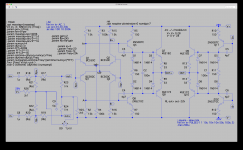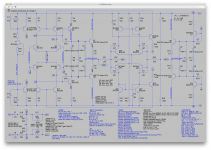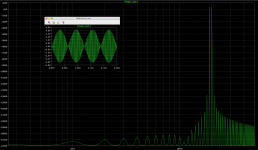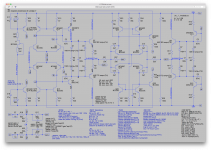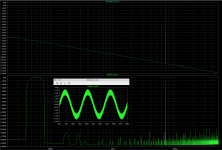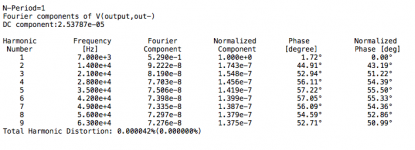It takes less than ms view on this basic circuit to realize your sim is on steroids.
What do you mean?
What's ms view?
Something wrong with the sim?
I've been seeking a potential replacement for the 2N5087/5210, because they're less available and there seems to be potential obsolescence coming very soon for them.
I couldn't find anything worth using, with possibly a little more Vceo, more Ic, not slower and at least about the same gain, or close to it. A potential pair could be the MPSA06/56, but they're much lower gain and are kind of going out of style as well, aiming to be phased out just like the 2N5...
Pain in the butt.
I've been using older versions of cordell's models for those 2, and they've been tweaked a little for gain and early voltage, but the gain tweaks I felt were a little too optimistic. I've been using those models but the npn/pnp gain and vaf values are identical, so too similar to compare to real world. So I made "tweaked" versions, to make them less similar, with different gains and vaf, although not hugely different, which could be achieved with a little work to pair them up from a big enough bunch. Finding pairs matched as well as the models is quite unlikely, so making the models a bit different makes some sense to reflect reality a bit more. Anyway, it does affect the offsets of course, but not the rest really, with same results.
I also "tweaked" a bit the mje182/72 pair to make them less similar. Those models came from onsemi (eek!). But I don't have any from other sources for those types.
Anyway, making those a bit more dissimilar as well doesn't affect anything really, just a bit the offsets.
I'm a bit surprised at how low the early voltage is for the mje182/82. It may be right, I'm not sure, but it seems on the low side to me.
Can anyone confirm early voltage values for those please? They're set at 12.5 for both in the models, which seems unlikely to me. Tweaking this to more realistic values would be nice.
I couldn't find anything worth using, with possibly a little more Vceo, more Ic, not slower and at least about the same gain, or close to it. A potential pair could be the MPSA06/56, but they're much lower gain and are kind of going out of style as well, aiming to be phased out just like the 2N5...
Pain in the butt.
I've been using older versions of cordell's models for those 2, and they've been tweaked a little for gain and early voltage, but the gain tweaks I felt were a little too optimistic. I've been using those models but the npn/pnp gain and vaf values are identical, so too similar to compare to real world. So I made "tweaked" versions, to make them less similar, with different gains and vaf, although not hugely different, which could be achieved with a little work to pair them up from a big enough bunch. Finding pairs matched as well as the models is quite unlikely, so making the models a bit different makes some sense to reflect reality a bit more. Anyway, it does affect the offsets of course, but not the rest really, with same results.
I also "tweaked" a bit the mje182/72 pair to make them less similar. Those models came from onsemi (eek!). But I don't have any from other sources for those types.
Anyway, making those a bit more dissimilar as well doesn't affect anything really, just a bit the offsets.
I'm a bit surprised at how low the early voltage is for the mje182/82. It may be right, I'm not sure, but it seems on the low side to me.
Can anyone confirm early voltage values for those please? They're set at 12.5 for both in the models, which seems unlikely to me. Tweaking this to more realistic values would be nice.
You could consider the ZTX692B (NPN) and ZTX792A (PNP).I've been seeking a potential replacement for the 2N5087/5210, because they're less available and there seems to be potential obsolescence coming very soon for them.
I couldn't find anything worth using, with possibly a little more Vceo, more Ic, not slower and at least about the same gain, or close to it. A potential pair could be the MPSA06/56, but they're much lower gain and are kind of going out of style as well, aiming to be phased out just like the 2N5...
About the original problem, it's a bit complicated.The feedback is negative for the differential mode but positive for the common mode.
The circuit will flip to one or the other end of allmost the voltage rails depeding on the start condition.
With R21 and R22 grounded to the +rail and with R26 in between to -rail.
The "solutions" i proposed are incapable to draw the input to the right level, the output via R17-R19 is pulling to strong (R17+R21 seems to be 7k5).
Perhaps a TL431 adjustable zener with 10mA is capable of imposing the disired voltage.
That is not always ground level, but what gives symetrical clipping.
You can adjust R25 for that.(if this works
Mona
Attachments
You could consider the ZTX692B (NPN) and ZTX792A (PNP).
I just pulled up the datasheets on those. I'm not familiar with those and never used them.
They seem indeed a little more "beefy", with a bit more dissipation capabilities and more Ic current. Vce0 70V, not too bad.
But just as they are priced quite a bit differently, they are also rather dissimilar for supposedly complementary parts. The Vbe(on) is quite a bit different, the hfe quite a lot as well, even their max dissipation and max Ic are rather different.
I looked up some spice models:
ZTX692B*ZETEX ZTX692B Spice Model v1.0 Last Revised 31/10/90
*
.MODEL ZTX692B NPN IS =1.87E-12 NF =.9983 BF =1400 IKF=0.73 VAF=29
+ISE=.21E-12 NE =1.378 NR =.997 BR =68 IKR=.55 VAR=12 ISC=.44E-12
+NC =1.14 RB =.2 RE =.05 RC =.048 CJC=42.5E-12 MJC=.475 VJC=.625
+CJE=233E-12 TF =.77E-9 TR =39E-9
*Note: This Model may be inaccurate for collector currents above 1.5A.
ZTX792A*ZETEX ZTX792A Spice Model v1.0 Last Revised 7/1/92
*
.MODEL ZTX792A PNP IS=5.98255E-13 NF=1.0022 BF=525 IKF=1.25 VAF=30
+ISE=1.45E-13 NE=1.54 NR=0.995 BR=75 IKR=0.4 VAR=34 ISC=1.58913E-13
+NC=1.03943 RB=0.06 RE=0.059 RC=0.08 CJC=90E-12 MJC=0.5 VJC=0.71
+CJE=286E-12 TF=0.75E-9 TR=93.75E-9
*Note, The Model may be inaccurate for collector currents above 1.2A.
And those models also seem rather different. With a BF for the ZTX692B that seems quite a lot unrealistic. I don't trust those models. And they even mention being inaccurate at different currents. Yeah, no ****!
If anyone has more reliable models, I could try them out.
About the original problem, it's a bit complicated.The feedback is negative for the differential mode but positive for the common mode.
The circuit will flip to one or the other end of allmost the voltage rails depeding on the start condition.
Indeed, very much out of control and unwieldy.
With R21 and R22 grounded to the +rail and with R26 in between to -rail.
The "solutions" i proposed are incapable to draw the input to the right level, the output via R17-R19 is pulling to strong (R17+R21 seems to be 7k5).
Perhaps a TL431 adjustable zener with 10mA is capable of imposing the disired voltage.
That is not always ground level, but what gives symetrical clipping.
You can adjust R25 for that.(if this works)
Mona
Seems a pretty "forceful" measure.
I don't have a TL431 model.
Have you tried running sims?
Should I post the sim that I have so others can also run it?
Ran a CCIF IMD sim. I wish there was some way to make the .four command work on this, as to get a final % number.
The side bands for the 19-20k fundamentals are just a tad above the -140db and the tip of those fundamentals are a bit above the 0db level, so the IMD stuff is all at more than 104db below that.
But how much is that, if taking all the harmonic orders into account in %???
This was done for an output level at about 3Vrms (+20dbu).
I'd like to find good current replacements for the 2N5087/5210, such that could be procured from outfits like mouser, digikey and the likes. Good spice models are a must of course.
The side bands for the 19-20k fundamentals are just a tad above the -140db and the tip of those fundamentals are a bit above the 0db level, so the IMD stuff is all at more than 104db below that.
But how much is that, if taking all the harmonic orders into account in %???
This was done for an output level at about 3Vrms (+20dbu).
I'd like to find good current replacements for the 2N5087/5210, such that could be procured from outfits like mouser, digikey and the likes. Good spice models are a must of course.
Attachments
The SMPTE IMD method is different, and because of the way the sources are hooked to the input, the signal strength isn't quite as much, keeping the 1:4 ratio.
But we can apply a notch filter to remove the 60hz fundamental and look at what's left from the 7k and the IMD products, and then the .four function seems to work ok with this and give a % number that seems fairly legit.
Hard to compare those readings tough, between the SMPTE and CCIF methods, since to begin with the output level isn't quite the same.
Lower distortion it seems under SMPTE, but that may only be because of the lower signal strength.
Can the .four result be trusted here? I wonder. But it may be ok if looking at the IMD products side bands off the 7k fundamental being at the most at some -150db below it.
But we can apply a notch filter to remove the 60hz fundamental and look at what's left from the 7k and the IMD products, and then the .four function seems to work ok with this and give a % number that seems fairly legit.
Hard to compare those readings tough, between the SMPTE and CCIF methods, since to begin with the output level isn't quite the same.
Lower distortion it seems under SMPTE, but that may only be because of the lower signal strength.
Can the .four result be trusted here? I wonder. But it may be ok if looking at the IMD products side bands off the 7k fundamental being at the most at some -150db below it.
Attachments
- Status
- This old topic is closed. If you want to reopen this topic, contact a moderator using the "Report Post" button.
- Home
- Source & Line
- Analog Line Level
- Buffer/DOA with balanced inputs/outputs
